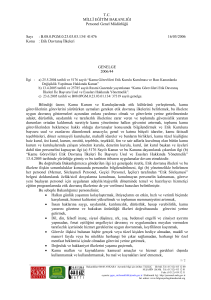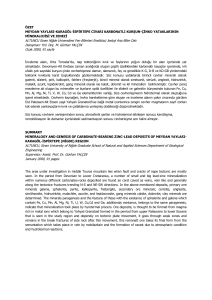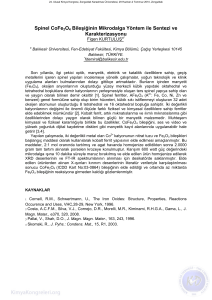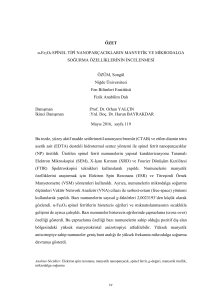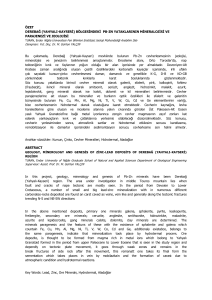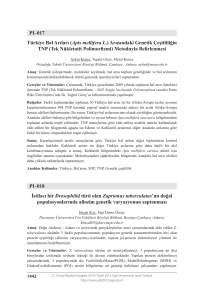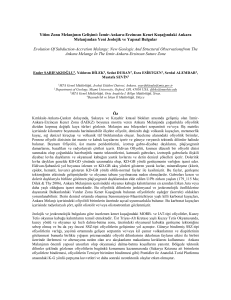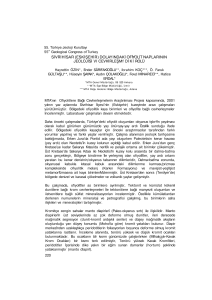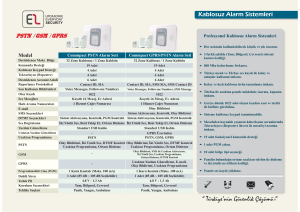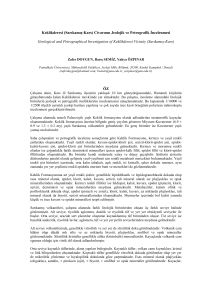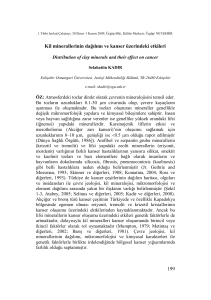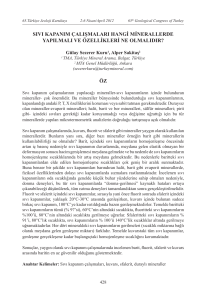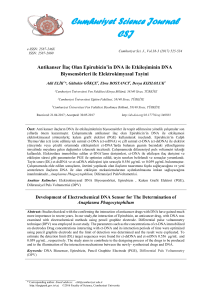Platinum- Group Minerals in Ophiolitic Chromitite rocks from
advertisement
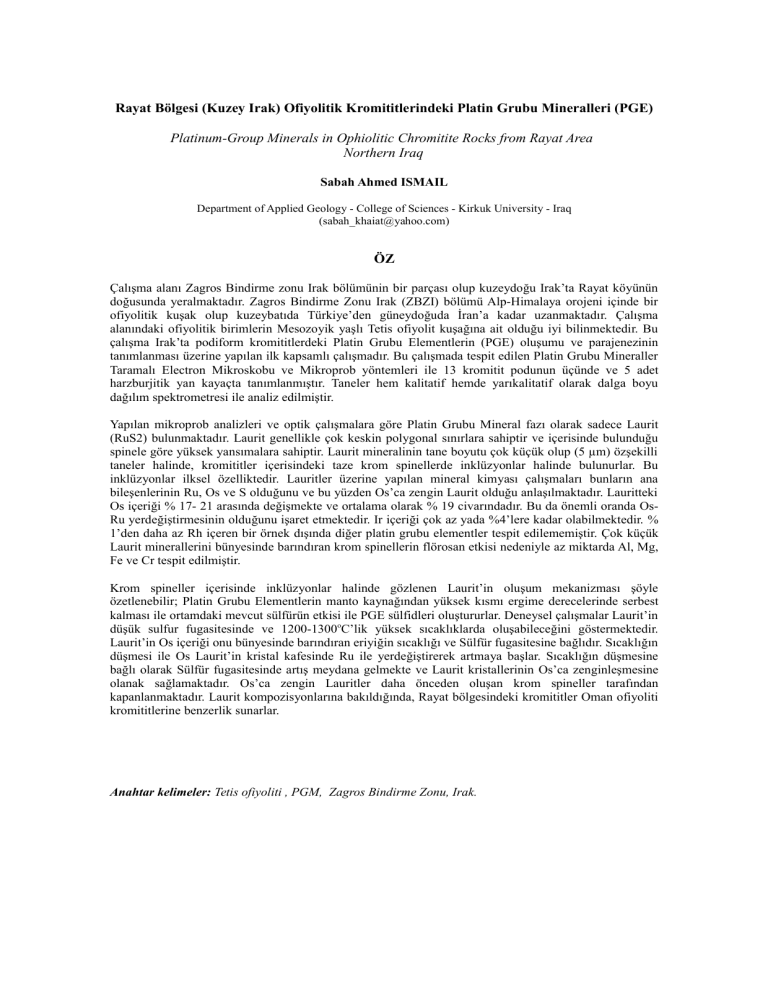
Rayat Bölgesi (Kuzey Irak) Ofiyolitik Kromititlerindeki Platin Grubu Mineralleri (PGE) Platinum-Group Minerals in Ophiolitic Chromitite Rocks from Rayat Area Northern Iraq Sabah Ahmed ISMAIL Department of Applied Geology - College of Sciences - Kirkuk University - Iraq ([email protected]) ÖZ Çalışma alanı Zagros Bindirme zonu Irak bölümünin bir parçası olup kuzeydoğu Irak’ta Rayat köyünün doğusunda yeralmaktadır. Zagros Bindirme Zonu Irak (ZBZI) bölümü Alp-Himalaya orojeni içinde bir ofiyolitik kuşak olup kuzeybatıda Türkiye’den güneydoğuda İran’a kadar uzanmaktadır. Çalışma alanındaki ofiyolitik birimlerin Mesozoyik yaşlı Tetis ofiyolit kuşağına ait olduğu iyi bilinmektedir. Bu çalışma Irak’ta podiform kromititlerdeki Platin Grubu Elementlerin (PGE) oluşumu ve parajenezinin tanımlanması üzerine yapılan ilk kapsamlı çalışmadır. Bu çalışmada tespit edilen Platin Grubu Mineraller Taramalı Electron Mikroskobu ve Mikroprob yöntemleri ile 13 kromitit podunun üçünde ve 5 adet harzburjitik yan kayaçta tanımlanmıştır. Taneler hem kalitatif hemde yarıkalitatif olarak dalga boyu dağılım spektrometresi ile analiz edilmiştir. Yapılan mikroprob analizleri ve optik çalışmalara göre Platin Grubu Mineral fazı olarak sadece Laurit (RuS2) bulunmaktadır. Laurit genellikle çok keskin polygonal sınırlara sahiptir ve içerisinde bulunduğu spinele göre yüksek yansımalara sahiptir. Laurit mineralinin tane boyutu çok küçük olup (5 µm) özşekilli taneler halinde, kromititler içerisindeki taze krom spinellerde inklüzyonlar halinde bulunurlar. Bu inklüzyonlar ilksel özelliktedir. Lauritler üzerine yapılan mineral kimyası çalışmaları bunların ana bileşenlerinin Ru, Os ve S olduğunu ve bu yüzden Os’ca zengin Laurit olduğu anlaşılmaktadır. Lauritteki Os içeriği % 17- 21 arasında değişmekte ve ortalama olarak % 19 civarındadır. Bu da önemli oranda OsRu yerdeğiştirmesinin olduğunu işaret etmektedir. Ir içeriği çok az yada %4’lere kadar olabilmektedir. % 1’den daha az Rh içeren bir örnek dışında diğer platin grubu elementler tespit edilememiştir. Çok küçük Laurit minerallerini bünyesinde barındıran krom spinellerin flörosan etkisi nedeniyle az miktarda Al, Mg, Fe ve Cr tespit edilmiştir. Krom spineller içerisinde inklüzyonlar halinde gözlenen Laurit’in oluşum mekanizması şöyle özetlenebilir; Platin Grubu Elementlerin manto kaynağından yüksek kısmı ergime derecelerinde serbest kalması ile ortamdaki mevcut sülfürün etkisi ile PGE sülfidleri oluştururlar. Deneysel çalışmalar Laurit’in düşük sulfur fugasitesinde ve 1200-1300oC’lik yüksek sıcaklıklarda oluşabileceğini göstermektedir. Laurit’in Os içeriği onu bünyesinde barındıran eriyiğin sıcaklığı ve Sülfür fugasitesine bağlıdır. Sıcaklığın düşmesi ile Os Laurit’in kristal kafesinde Ru ile yerdeğiştirerek artmaya başlar. Sıcaklığın düşmesine bağlı olarak Sülfür fugasitesinde artış meydana gelmekte ve Laurit kristallerinin Os’ca zenginleşmesine olanak sağlamaktadır. Os’ca zengin Lauritler daha önceden oluşan krom spineller tarafından kapanlanmaktadır. Laurit kompozisyonlarına bakıldığında, Rayat bölgesindeki kromititler Oman ofiyoliti kromititlerine benzerlik sunarlar. Anahtar kelimeler: Tetis ofiyoliti , PGM, Zagros Bindirme Zonu, Irak. ABSTRACT The study area is a part of the Iraqi Zagros Thrust Zone, situated east of Rayat village within the northeastren corner of Iraq. Iraqi Zagross Thrust Zone (IZTZ) is an ophiolitic belt, which belongs to the Alpine-Himalayan Orogenic Belt, and extends southeastward to Iran and northwestward to Turkey. It has been well recognized that the ophiolite belongs to the Tethyan ophiolitic belt of Mesozoic age . This is the first comprehensive description of occurrence and paragensis of platinum-group minerals (PGM) in podiform Chromitites from Iraq. PGM described in this paper have been found in three of the thirteen chromitite pods and five of harzburgite host rock using SEM (scanning electron microscope), and microprobe. The grains were analyzed both qualitatively and semiquantitatively using wavelengthdispersion spectroscopy (WDS). According to optical properties and microprobe analyses, Laurite ( RuS2) form the only PGM phase. Laurite usually have very sharp, polygonal boundaries and has high reflectivity with respect to host spinel. The grain size of the Laurite minerals are very small up to 5um, have euhedral shape and form as inclusion in fresh chromian spinel minerals within chromitite rocks, these inclusions are primary origin. The microprobe analyses of Laurite demonstrates exclusive presence of Ru, Os and S as major constituents, therefor the laurite is Os rich variety. The Os content varies from 17 up to 21 wt%, and is on 19 wt% average, indicating remarkable extent of substitution of Os for Ru. The Ir content are low ranging from not detected up to 4 wt%, other platinum-group elements are not detected except one sample contain less than 1 wt% from Rh element. Minor amount of Al, Mg, Fe and Cr have been detected due to a fluorescence effect from chromian spinel host because of small grain size of laurite minerals. Mechanism of laurite formation as inclusions in chromian spinel can be summarized as flow; after liberation of PGE from the mantle source at high degree of partial melting, they tend to form PGE sulfides with presence of available of Sulfur. Experimental studies show that, laurite can form at low fugacity of Sulfur and high temperature around 1200-1300°C. Os content of laurite depended on the temperature and Sulfur fugacity of the host melt, Os content increase as substitution for Ru in the crystal structure of laurite with decreasing temperature. Decreasing temperature, Sulfur fugacity will increase allowing laurite crystals to be more rich in Os content before entrapment by the early-formed crystals of chromian–spinel. In term of laurite composition, the Rayat chromitite rocks is similar to Oman ophiolitic chromitite rocks. Keywords: Tethyan Ophiolite , PGM, Iraqi Zagros Thrust Zone, Iraq.
